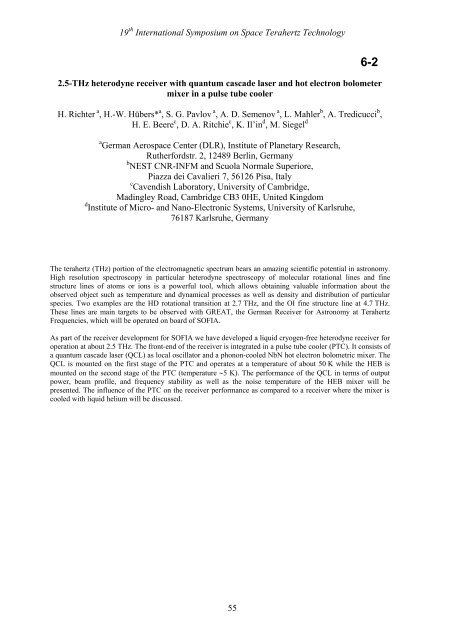Program and Abstract Book - SRON
Program and Abstract Book - SRON
Program and Abstract Book - SRON
Create successful ePaper yourself
Turn your PDF publications into a flip-book with our unique Google optimized e-Paper software.
19 th International Symposium on Space Terahertz Technology<br />
6-2<br />
2.5-THz heterodyne receiver with quantum cascade laser <strong>and</strong> hot electron bolometer<br />
mixer in a pulse tube cooler<br />
H. Richter a , H.-W. Hübers* a , S. G. Pavlov a , A. D. Semenov a , L. Mahler b , A. Tredicucci b ,<br />
H. E. Beere c , D. A. Ritchie c d<br />
d<br />
, K. Il’in , M. Siegel<br />
a German Aerospace Center (DLR), Institute of Planetary Research,<br />
Rutherfordstr. 2, 12489 Berlin, Germany<br />
b NEST CNR-INFM <strong>and</strong> Scuola Normale Superiore,<br />
Piazza dei Cavalieri 7, 56126 Pisa, Italy<br />
c Cavendish Laboratory, University of Cambridge,<br />
Madingley Road, Cambridge CB3 0HE, United Kingdom<br />
d Institute of Micro- <strong>and</strong> Nano-Electronic Systems, University of Karlsruhe,<br />
76187 Karlsruhe, Germany<br />
The terahertz (THz) portion of the electromagnetic spectrum bears an amazing scientific potential in astronomy.<br />
High resolution spectroscopy in particular heterodyne spectroscopy of molecular rotational lines <strong>and</strong> fine<br />
structure lines of atoms or ions is a powerful tool, which allows obtaining valuable information about the<br />
observed object such as temperature <strong>and</strong> dynamical processes as well as density <strong>and</strong> distribution of particular<br />
species. Two examples are the HD rotational transition at 2.7 THz, <strong>and</strong> the OI fine structure line at 4.7 THz.<br />
These lines are main targets to be observed with GREAT, the German Receiver for Astronomy at Terahertz<br />
Frequencies, which will be operated on board of SOFIA.<br />
As part of the receiver development for SOFIA we have developed a liquid cryogen-free heterodyne receiver for<br />
operation at about 2.5 THz. The front-end of the receiver is integrated in a pulse tube cooler (PTC). It consists of<br />
a quantum cascade laser (QCL) as local oscillator <strong>and</strong> a phonon-cooled NbN hot electron bolometric mixer. The<br />
QCL is mounted on the first stage of the PTC <strong>and</strong> operates at a temperature of about 50 K while the HEB is<br />
mounted on the second stage of the PTC (temperature ∼5 K). The performance of the QCL in terms of output<br />
power, beam profile, <strong>and</strong> frequency stability as well as the noise temperature of the HEB mixer will be<br />
presented. The influence of the PTC on the receiver performance as compared to a receiver where the mixer is<br />
cooled with liquid helium will be discussed.<br />
55
















